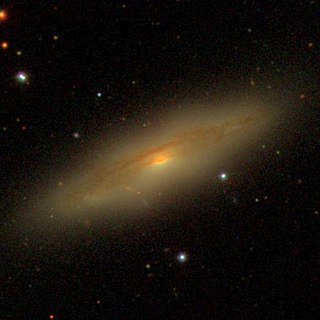NGC 4586
Spiral galaxy in the constellation Virgo From Wikipedia, the free encyclopedia
NGC 4586 is a spiral galaxy located about 50 million light-years away[2] in the constellation Virgo.[3] The galaxy was discovered by astronomer William Herschel on February 2, 1786.[4] Although listed in the Virgo Cluster Catalog,[5] NGC 4586 is considered to be a member of the Virgo II Groups which form a southern extension of the Virgo cluster.[6][7] NGC 4586 is currently in the process of infalling into the Virgo Cluster and is predicted to enter the cluster in about 500 million years.[8]
| NGC 4586 | |
|---|---|
 SDSS image of NGC 4586. | |
| Observation data (J2000 epoch) | |
| Constellation | Virgo |
| Right ascension | 12h 38m 28.4s[1] |
| Declination | 04° 19′ 09″[1] |
| Redshift | 0.002648[1] |
| Heliocentric radial velocity | 794 km/s[1] |
| Distance | 51 Mly (15.5 Mpc)[1] |
| Group or cluster | Virgo II Groups |
| Apparent magnitude (V) | 12.7[1] |
| Characteristics | |
| Type | SA(s)a[1] |
| Size | ~60,900 ly (18.68 kpc) (estimated)[1] |
| Apparent size (V) | 2.90 x 0.99[1] |
| Other designations | |
| CGCG 42-187, IRAS 12359+0435, MCG 1-32-122, PGC 42241, UGC 7804, VCC 1760[1] | |
Boxy/Peanut bulge
NGC 4586 has a boxy or peanut-shaped bulge. The bulge has been interpreted to be a bar viewed edge-on.[9][10]
See also
References
External links
Wikiwand - on
Seamless Wikipedia browsing. On steroids.
